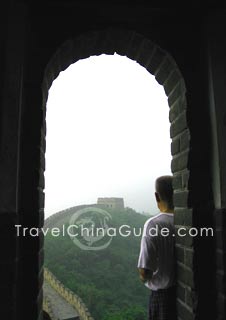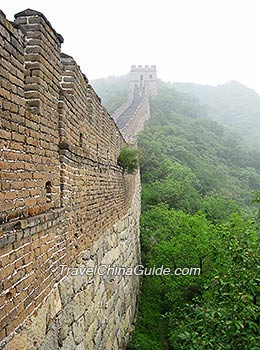Mutianyu Great Wall Travel Review
![]() Author & Photographer: Dustin D. Ooley (USA)
Author & Photographer: Dustin D. Ooley (USA)
 |
| Dustin and his friend at Mutianyu |
One of the most common myths about the Great Wall is that the wall is continuous: one long and twisting stone dragon designed to protect China from northern invaders. While the Great Wall is indeed thousands of kilometers long, its distance is a result of several sections added together. In fact, historically the wall wasn't always made of stone. The different sections were built during various periods of Chinese history. Walls existed before the Qin dynasty, but the first emperor ordered them torn down as he worked to unify the country. Most of the Qin walls, built to defend China against the north, have eroded, and little remains today. Other sections built in the Han, Sui, Northern and Jin dynasties still remain today, but that's largely due to massive reconstruction and expansion during the Ming Dynasty. The Ming walls made use of stone, rather than compacted earth. The erosion of the earlier sections made from compressed earth is a testament to the long history of this man-made construction, though the unreconstructed sections of stone are also indications of its old age. The wall sections are so diverse and vast that in 2009 nearly 300 kilometers of Ming wall were found buried in sand.
 |
| Great Wall seen through the tower gate |
Mutianyu is basically in a forest running along a ridge. In the summer it feels like a rainforest with humid air and green verdant landscape. The wall has its own animal life, with lizards, ants, and other bugs accessible to the careful observer. The visitors were scarce for China, though people I know have complained about it being too "touristy". I really didn't think so, but perhaps it was the day we went (Thursday in late July). Occasionally it was possible to have one part (guard tower to guard tower) to myself, and somehow this brief solitude makes the wall seem so much larger and more impossible.
There are people with beverages and snacks in nearly every tower who are happy to sell you a bottle of water for 5 RMB. We were happy that we brought our own food.
One of my favorite things about this section of the wall is the lack of supervision. Climbing didn't seem to be against the rules, nor was it even discouraged. I spent much of my time scrambling to the tops of guard towers, while others just looked up at me through square holes in the ceiling of each tower. I was almost happy the day was rather foggy, giving me more of a chance to focus on enjoying the wall rather than worrying about taking pictures. Once, when my foot slipped while climbing a tower, I suddenly understood the 1 RMB insurance that was available at the entrance gate. Be cautious and don't get over-confident – even on the close-set, little stair steps; a slip and fall here would be the beginning of a long day.
I would recommend not taking the cable car for a first visit; seeing the wall through trees for the first time is an experience far more worthwhile, even if you have to hike for about 40 minutes to get there. Take your time, go early, and bring plenty of sunscreen: there's a lot to explore here.
If you haven't seen the Great Wall, and you're interested in a cheap, convenient, less touristy option, then check out the Mutianyu section. Most hotels and hostels in Beijing will offer tours, and often you can check out the packages at different hostels. I still recommend making the solo trip only for the most adventurous travelers (and those who speak a little Chinese).
Information about DIY to the Wall
 |
| Mutianyu in mist |
Avoiding the tourist packages has a couple of drawbacks. The first problem was not having anyone to explain the history as we wandered around. If you don't care much about history, or you have a book that explains things, this isn't a problem. The other issue was time. Using public transportation, while cutting the price significantly, takes a long time. Plan to spend a day with transportation and 5 hours at the wall. Dividing the costs between us, we spent about
1. Bus 916 from Dongzhimen to Huairou (4.4 RMB with Beijing bus card)
2. Private car from Huairou to Mutianyu (25 RMB) - There was a public bus option from Huairou, but it didn't arrive until later.
3. Entrance fee (45 RMB)
4. Bus 936 from Mutianyu to Dongzhimen (6 RMB)
For a total of about 68 RMB.
Later we realized that the 936 Goes to the wall and back from Dongzhimen (6 RMB each way). Why bother with going to Huairou? Therefore our revised version would look like this:
1. Bus 936 from Dongzhimen to Mutianyu (6 RMB)
2. Entrance fee (45 RMB)
3. Bus 936 from Mutianyu to Dongzhimen (6 RMB)
For a total of 57 RMB per person. Nice.
 Recommended tours including the visit to Mutianyu:
Recommended tours including the visit to Mutianyu:
One Day Great Wall Tour, Two Days Package![]() Further Reading:
Further Reading:![]() Introduction to Mutianyu Great Wall
Introduction to Mutianyu Great Wall![]() 6 Things to Do on Mutianyu Great Wall of China
6 Things to Do on Mutianyu Great Wall of China![]() Mutianyu Hiking
Mutianyu Hiking![]() Mutianyu Pictures
Mutianyu Pictures![]() Mutianyu Map
Mutianyu Map
- Last updated on Aug. 02, 2022 -